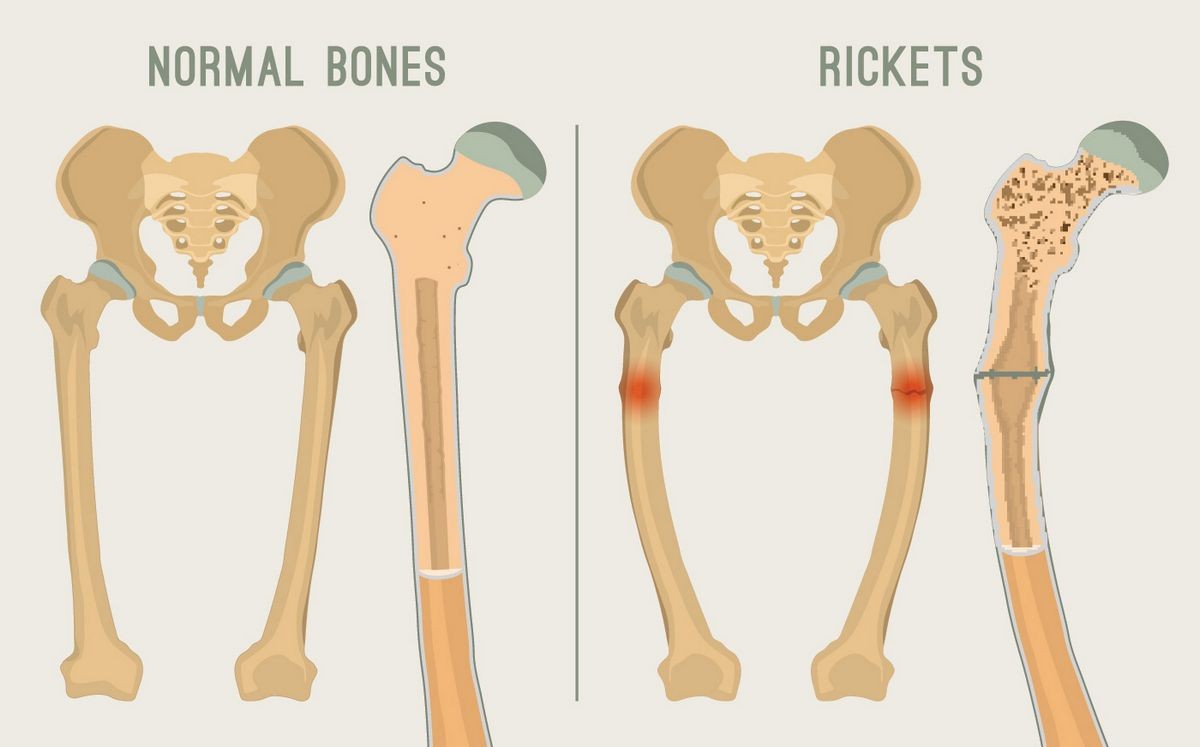
Contents
- 1 Rickets (Calcium, Phosphate, or Vitamin D Deficiency)
- 1.0.1 What is the history of rickets?
- 1.0.2 What are risk factors for rickets?
- 1.0.3 What causes rickets?
- 1.0.4 What are rickets symptoms and signs?
- 1.0.5 Who treats rickets?
- 1.0.6 How is rickets diagnosed?
- 1.0.7 What is the treatment for rickets?
- 1.0.8 What is the prognosis for rickets?
- 1.0.9 Is it possible to prevent rickets?
Rickets (Calcium, Phosphate, or Vitamin D Deficiency)
Rickets is a bone disorder caused by a deficiency of vitamin D, calcium, or phosphate. It leads to softening and weakening of the bones and is most common in children aged 6-24 months. There are several subtypes of rickets, including hypophosphatemic rickets (vitamin-D-resistant rickets), renal or kidney rickets (renal osteodystrophy), and nutritional rickets (caused by dietary deficiency of vitamin D, calcium, or phosphate). Classic nutritional rickets is also medically termed osteomalacia.
What is the history of rickets?
Roman descriptions of individuals with rickets can be found as early as the second century, and in the 1640s, the condition was well documented as a common bone ailment across England. Unfortunately, the scientifically proven cause of rickets was not identified until the 1920s, and by the 1930s, public-health initiatives recommended fortifying milk with vitamin D and cod-liver oil as a nutritional supplement for young infants and children. This led to a near eradication of rickets in the United States and other industrialized nations. Unfortunately, rickets has made a comeback and is still common in less-developed nations. Moreover, for a variety of reasons, rickets is seen more frequently among infants and children living in industrialized nations, often among more affluent populations.
What are risk factors for rickets?
Rickets risk factors include:
- premature birth (low levels of vitamin D, calcium, and phosphorus);
- limited sun exposure (especially in high and low latitudes);
- hereditary metabolic diseases (for example, X-linked hypophosphotemic rickets);
- darkly pigmented individuals;
- infants born to vitamin D-deficient mothers;
- renal (kidney) diseases that affect calcium and phosphorus absorption; and
- nutrition — suboptimal calcium and phosphorus intake or low vitamin D intake (seen in certain vegan diets due to avoidance of milk/dairy products). Soy milk and breakfast cereals fortified with vitamin D are helpful.
QUESTION
What causes rickets?
Regardless of the type of rickets, the cause is always a deficiency of vitamin D, calcium, or phosphate. Three common causes of rickets include nutritional rickets, hypophosphatemic rickets, and renal rickets.
Nutritional rickets
Nutritional rickets, also called osteomalacia, is a condition caused by vitamin D deficiency. Vitamin D is necessary for the normal formation of bones and teeth and for the absorption of calcium and phosphorus from the bowels. It occurs naturally in some foods such as saltwater fish (salmon, sardines, herring, and fish-liver oils). Vitamin D is also produced by skin cells in response to sunlight exposure.
Infants and children most at risk for developing nutritional rickets include dark-skinned infants, exclusively breastfed infants, and infants born to mothers who are vitamin D deficient. In addition, older children who are kept out of direct sunlight or who have vegan diets may also be at risk.
Hypophosphatemic rickets
Hypophosphatemic rickets is caused by chronically low levels of phosphate in the blood. This is caused by a genetic defect in the ability of the kidneys to control phosphate excretion. Patients with hypophosphatemic rickets typically have obvious symptoms by 1 year of age. Treatment is generally through nutritional supplements of phosphate and calcitriol (the activated form of vitamin D).
Renal (kidney) rickets
Renal rickets is caused by kidney disorders that affect the regulation of calcium and phosphate absorption. Treatment involves addressing the underlying kidney problem and providing nutritional supplementation.
What are rickets symptoms and signs?
Signs and symptoms of rickets include bone pain or tenderness, dental deformities, delayed formation of teeth, decreased muscle strength, predisposition to infections, impaired growth, short stature, and skeletal deformities, including abnormally shaped skull, bowlegs, rib-cage abnormalities, and breastbone, pelvic, and spinal deformities.
In severe cases, patients may develop more serious signs and symptoms associated with very low levels of calcium or phosphate. These may include tetany or seizures, which require immediate treatment.
Who treats rickets?
Pediatricians and family practitioners usually care for children with nutritional rickets without consulting specialists. Kidney specialists (nephrologists) help manage renal rickets, and sometimes a pediatric endocrinologist may get involved.
How is rickets diagnosed?
Rickets is diagnosed through a complete medical and nutritional history, a physical exam, and X-rays of the bones. Laboratory tests are also conducted to evaluate vitamin D levels, alkaline phosphatase, parathyroid hormone, electrolytes, and kidney function.
What is the treatment for rickets?
The treatment for rickets depends on the cause. For nutritional rickets and vitamin D deficiency, treatment involves correcting abnormal calcium and phosphate levels with supplements and activated vitamin D. A calcium-rich diet is also important, especially for children on vegan diets. Bony abnormalities may require evaluation by an orthopedic provider.
What is the prognosis for rickets?
Outcomes for children with nutritional rickets are excellent, especially if diagnosed early. Supplementation with calcium and vitamin D leads to healing of bony defects. In cases of severe bowing, resolution may take a number of years without surgical intervention. In advanced disease, the bony changes may be permanent.
Is it possible to prevent rickets?
Pediatricians, family practitioners, and obstetricians educate parents about measures to prevent rickets. This includes prenatal vitamins and appropriate nutritional counseling for expecting mothers, as well as vitamin D supplementation for breastfed babies and reasonable sun exposure as the child gets older. The safe amount of sunlight exposure for infants and children needs further research to successfully prevent rickets worldwide.
References:
Balk, S.J. "UV Radiation: A Hazard to Children and Adolescents." Pediatrics 127.3 Mar. 2011: e791-e817.
DiMaggio, Dina M., et al. "Update in Infant Nutrition." Pediatrics in Review 38.10 October 2017: 449-462.
Mughal, M.Z. "Rickets." Current Osteoporosis Report 9.4 Dec. 2011: 291-299.


